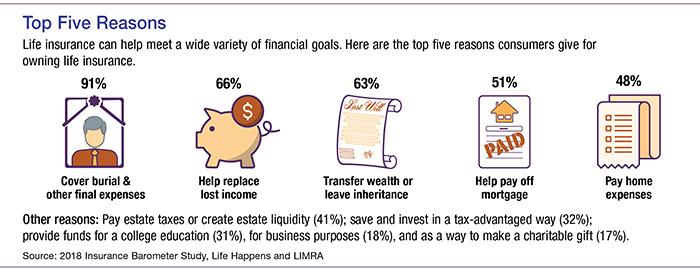Protection to Help Your Family
A recent survey found that 35% of U.S. households would face financial adversity within one month if a primary wage earner died. This risky situation reflects a widespread lack of protection. More than 40% of adults have no life insurance coverage, and about 20% of those who do have coverage say they do not have enough. 1
The most common reasons people give for not purchasing life insurance are that it is too expensive and/or they have other financial priorities. Thats not surprising money can only go so far but life insurance is not as expensive as many people think. Most consumers estimate the cost of coverage at more than three times its actual cost. 2
If you need more coverage or have no coverage at all, its worth exploring the true costs and available options.

How Much Do You Need?
A common guideline suggests having coverage equivalent to at least seven to 10 times the insureds annual salary, but some people may need more. There is no universal formula, and the amount you need depends on your familys living expenses and other sources of income. Your financial professional can help you assess your needs more comprehensively.
You may have group life insurance through work, but the face value of employer-based policies is generally low typically one or two times your annual salary. And you might lose coverage if you change employers. An individual policy is yours to keep for as long as you pay the premiums. Two basic types of individual life insurance are available.
Term vs. Perm
Term life insurance is generally the most affordable. As the name suggests, this type of coverage offers a death benefit if you die within the covered time period, which could range from one to 30 years. Premiums may adjust each year or remain fixed for the full term. You might be able to continue coverage beyond the original term at a higher premium, or convert to a permanent policy (subject to age restrictions and policy minimums) while the policy is in force.
Permanent life insurance (also called whole life) offers lifetime protection and a guaranteed death benefit as long as you keep the policy in force by paying the premiums. Although the premium is usually higher than for term insurance, it typically remains level for the rest of your life.
A portion of the permanent life insurance premium goes into a cash-value account, which accumulates on a tax-deferred basis throughout the life of the policy. You might be able to borrow against the cash value during your lifetime to help pay for retirement, education, emergencies, or other needs.
Withdrawals of the accumulated cash value, up to the amount of the premiums paid, are not subject to income tax. Loans (as long as they are repaid) are also free of income tax. Loans and withdrawals from a permanent life insurance policy will reduce the policys cash value and death benefit, and may require additional premium payments to keep the policy in force. Any guarantees are contingent on the financial strength and claims-paying ability of the issuing insurance company.
The cost and availability of life insurance depend on factors such as age, health, the type and amount of insurance purchased. Policies commonly have mortality and administrative charges beyond the cost of premiums. If a permanent life policy is surrendered prematurely, there may be surrender charges and income tax implications.
